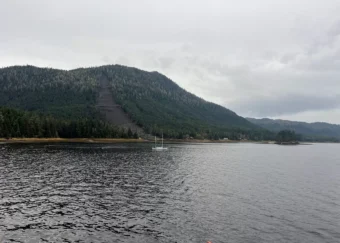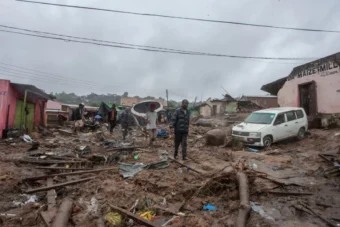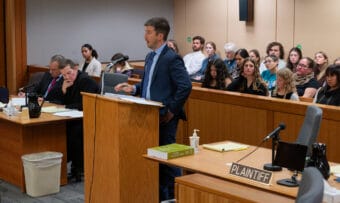
Arctic methane explosions and the scientists who love to study them are the focus of the newest episode of the public television program Nova.
The show follows University of Alaska Fairbanks researchers investigating the appearance of craters, sometimes big ones, in northern regions. That’s where a rapidly warming climate has thawed permafrost and allowed more methane to percolate upward from deeper in the Earth. As the thinking goes, the methane travels upwards and forms a kind of tube, not unlike magma in a volcano, and then builds up pressure at the surface until — kaboom! — it erupts, sometimes even with a fiery explosion.
Longtime permafrost researcher Dr. Vladimir Romanovsky with UAF’s Geophysical Institute, a professor emeritus as of this week, is featured in the Nova episode that aired Wednesday night. And Romanovsky says there are several reasons to keep an eye on the exploding methane phenomenon.
Listen here:
The following transcript has been lightly edited for clarity.
Vladimir Romanovsky: So it’s still in discussion, the process, the physical process behind this phenomena. But I think it’s more and more clear that there is some protrusion of high pressure gas, and this protrusion goes from below the bottom of permafrost toward the surface. And eventually, when the pressure is high, then it just erupts and removes this cap. And these pieces of frozen material and the big chunks of ice are flying away, very far sometimes, like 300 feet and even more away from the crater. And sometimes even there is some evidence that during this eruption, coming out, methane was ignited, and it was not just eruption, but eruption and then explosion. And yeah, people are aware of it, and they are monitoring. And of course, the satellite data is high, very high resolution, and are also now used very, very widely to, first of all, to look for these existing craters and how they change with time, but also looking at suspicious, little hills, round hills, the right size, and potentially could be those ones ready — sooner or later — to explode or to erupt.
Casey Grove: Some of those hills, maybe now you’re thinking, they’re not full of ice, they might be suspiciously full of methane, then?
Vladimir Romanovsky: Yeah, and not just full, but this high pressure. So it makes it dangerous to try to just simply drill into these hills. You may not survive, you know, because the pressure is very high, and also possibly there could be ignition. So it would make a really serious explosion and definitely will be not safe. Definitely. I wouldn’t recommend anybody to drill in those in those hills.
Casey Grove: I will note that for future reference, in case I find myself in that position.
Vladimir Romanovsky: Yeah. Just stay from a distance and look.
Casey Grove: Why is this happening? I mean, why is this showing up here relatively recently?
Vladimir Romanovsky: That’s a very good question. Why now? Why not before? And, of course, what really happened, what changed? Well, the climate warming. So that’s why, the first kind of reaction to explain why now. It’s related to a warmer climate, and why a warmer climate would trigger this, this phenomena, that’s where we need to have a very good understanding of the physics, the processes behind it. I have a very possible scenario why it is happening. And this explanation is, well, pretty straightforward. So this protrusion from below may be happening for a long, long time. But before, the permafrost was much colder. We have data, we have our measurements, going on for the last 40 years. And we see that, for example, permafrost on the North Slope now is about 3-4 degrees warmer near to the surface of permafrost, compared to 30-35 years ago. So now, warmer permafrost will allow this protrusion to come closer and closer to the ground surface and eventually allow these eruptions.
Casey Grove: And I guess the concern isn’t just that you might be standing nearby and the thing would explode, or if you were drilling into it or whatever, it has to do with the actual methane being released into the atmosphere. Can you explain that?
Vladimir Romanovsky: Yeah, that’s true. And the amount of methane which will be released during the eruption is not that much. And especially if it explodes, then methane will just turn into CO2 and water, pretty much. But if this chimney or connection to below permafrost environment will be still open, which we see in some cases — it’s still open in this case — it’s allowed to escape a much, much larger amount of methane, which is sequestered there and otherwise will be sitting there for, you know, millennia, it will be able to escape to the atmosphere. It’s still a question of how much. It’s still a question, it needs to be assessed and estimated, but it may be one of the potential sources of increase in methane concentration in the atmosphere, increasing this greenhouse effect, because it’s a very, very potent greenhouse gas.
Casey Grove: And that would just sort of cause a feedback loop and maybe even make the problem worse, I imagine?
Vladimir Romanovsky: That’s right. Yeah, the more greenhouse gas concentration, faster warming. Faster warming and permafrost thaw, more right conditions in more areas where it isn’t possible right now, and more explosions and so on. But I wouldn’t kind of neglect the possibility of problems with infrastructure with that, because according to my theory, this phenomena happens in the areas of warmer permafrost. And also, we know that any large infrastructure makes permafrost warmer. So in this case, this protrusion will actually be directed toward the warmer permafrost, which is under infrastructure, and that makes it very dangerous. So, you see, it’s kind of some sort of heat-directed missile, you know. It goes to the source of heat. Of course, it’s speculation. Of course, it’s kind of like an interesting twist in this phenomena, but it’s possible.
Casey Grove: Yeah, that does seem pretty troubling, and also interesting, just that, if that’s the case that it goes toward those things, it definitely seems worth studying more.
Vladimir Romanovsky: Right. And in the Yamal Peninsula, in Siberia, several of them have already happened. And very, very close to this Bovanenkovskoye gas field infrastructure, to the pipelines. So for them, it’s not a theoretical, potentially possible problem, but it is real problem. They’re already pretty much worried about what is going on there.
Casey Grove: Wow, yeah. And also I thought I’d ask, while I have you on right now, about your retirement, because I think I read that you are retiring from the Geophysical Institute after something like 30 years, right?
Vladimir Romanovsky: Right. Well, it’s my second day of retirement today.
Casey Grove: And you’re still talking to me while you’re retired?
Vladimir Romanovsky: Well, I am a professor emeritus, which allows me to be active and to be present at the Geophysical Institute. So for for a while, they will keep some office for me, and I have even free parking. So that’s my privilege. So I will be around as a professor emeritus, and I will talk to anybody who would like to know more about permafrost and permafrost-related questions.
Casey Grove: That’s great. And, I mean, as a former UAF person myself, I know that the parking really does matter. You know, Dr. Romanovsky, I thought I would ask, just as a Fairbanks person myself — and, you know, having been born there, I didn’t have much of a choice — but I like to ask people that moved to Fairbanks, why did you end up there? How did you end up in Fairbanks?
Vladimir Romanovsky: Well, Fairbanks is very, very proper — and obvious even — choice for a person who studies permafrost. My previous life, scientific life, was related to Moscow State University, which is in Moscow. And even in all American movies about Moscow, it’s always winter and it’s always snowy. There is, unfortunately, no permafrost around Moscow. And to study permafrost, we had to go far, far away from it. And Fairbanks is a great place. It’s a great place. First of all, because permafrost is just around — just outside. But also because the University of Alaska Fairbanks and the University of Alaska in general, it’s a very, very great scientific institution. So it’s a worldwide kind of leader in the cold regions research. And it’s a great place to be to study permafrost, because I have the huge knowledge of people around me. And any question I have, outside of my expertise, I can go and simply ask and work with those people around me. So that was great place, great decision on my side to come here and I’m very happy to be here.
Casey Grove: It sounds like you’re not leaving anytime soon for somewhere warmer, where you don’t have to just drive up the haul road to do permafrost research.
Vladimir Romanovsky: No, I will be here for a while, yes. It’s not easy to get rid of me.


